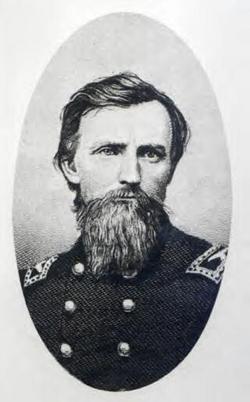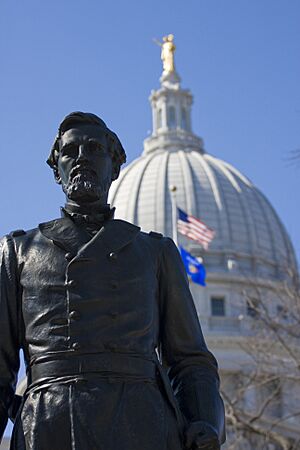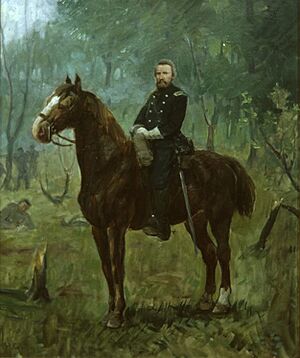Hans Christian Heg facts for kids
Quick facts for kids
Hans Christian Heg
|
|
|---|---|
 |
|
| 6th Prison Commissioner of Wisconsin | |
| In office January 2, 1860 – January 6, 1862 |
|
| Governor | Alexander Randall |
| Preceded by | Edward M. McGraw |
| Succeeded by | Alexander P. Hodges |
| Personal details | |
| Born | December 21, 1829 Lier, Norway |
| Died | September 20, 1863 (aged 33) Chickamauga, Georgia, U.S. |
| Resting place | Norway Cemetery, Norway, Wisconsin |
| Political party | Republican |
| Military service | |
| Allegiance | United States |
| Branch/service | United States Volunteers Union Army |
| Years of service | 1861–1863 |
| Rank | Colonel, USV |
| Unit | 15th Reg. Wis. Vol. Infantry 3rd Bde, 1st Div, XX Corps |
| Battles/wars | American Civil War |
Hans Christian Heg (December 21, 1829 – September 20, 1863) was an important Norwegian American figure. He was known for fighting against slavery and for his role as a soldier. He led the 15th Wisconsin Infantry Regiment during the American Civil War. This regiment was made up mostly of soldiers from Scandinavian countries. Colonel Heg sadly died from injuries he received at the Battle of Chickamauga.
Contents
Early Life and Moving to America
Hans Christian Heg was born in Lier, Norway, on December 21, 1829. He was the oldest of four children. His family moved to America in 1840 when Hans was eleven years old. They settled in the Muskego Settlement in Wisconsin. Even as a young boy, Hans was known for being very smart and talented.
Becoming a Leader and Fighting for Change
When Hans Heg was twenty, he went to California to search for gold. He spent two years there before returning to Wisconsin in 1851. After his father passed away, he married Gunhild Einong.
Heg became a major in the Wisconsin Militia. He was also a rising young politician who strongly disliked slavery. He spoke out against slavery and was a leader of the "Wide Awakes" in Wisconsin. This group worked against those who tried to capture escaped enslaved people. Heg joined the Free Soil Party, which opposed the expansion of slavery. Later, he joined the new Republican Party.
In 1859, Heg was elected as the commissioner of the state prison in Waupun. He was the first person born in Norway to be elected to a statewide office in Wisconsin. He worked to make many improvements to the prison system. He believed prisons should help people change for the better. In 1860, he bravely helped shelter Sherman Booth. Booth was a federal fugitive for helping an enslaved person escape. This act put Heg's own career at risk.
Serving in the Civil War
When the American Civil War began, Governor Alexander Randall chose Heg to be a colonel. Heg was to lead the 15th Wisconsin Infantry Regiment. He encouraged young "Norsemen" (people from Norway) to join. He told them it was their duty to defend their new country.
The 15th Wisconsin was called the "Scandinavian Regiment." Most of its soldiers were immigrants from Norway, Denmark, and Sweden. It was the only all-Scandinavian regiment in the Union Army.
On October 8, 1862, Colonel Heg led his regiment into their first battle at Battle of Perryville. Even though they were pushed back by the enemy, the regiment had few injuries and no deaths. Colonel Heg himself was hurt when his horse fell.
Heg also commanded his regiment during the Battle of Stones River. Because of his brave actions there, he was given command of a new group of soldiers. This was the 3rd Brigade of the 1st Division, XX Corps. He then fought in the Tullahoma campaign in 1863.
On September 18, 1863, Heg led his brigade at the Battle of Chickamauga. He was shot in the stomach by a Confederate sharpshooter. He tried to keep leading his troops but eventually had to give up command. He was taken to a hospital where he died the next morning, September 20. A surgeon who was there said it was very sad to see him suffer. Many friends who visited him cried. Everyone who knew him loved him.
General William Rosecrans was very sad to hear of Heg's death. He said Heg was a brave officer and he had planned to promote him to general. Heg was one of five colonels from Wisconsin who died in combat during the Civil War. He was the highest-ranking officer from Wisconsin killed in the war.
Heg was buried at the Norway Lutheran Church Cemetery in Wisconsin.
Statue Vandalism and Restoration

A statue of Hans Christian Heg was placed in Madison, Wisconsin, in 1925. On June 23, 2020, the statue was pulled down by a towing vehicle. It was then damaged and thrown into Lake Monona. Another statue, called Forward, was also pulled down. Both statues were later found by authorities. Heg's statue had lost a leg.
On July 20, 2020, officials voted to fix and put both statues back in their original spots. Since Heg's statue head was missing, a new one was planned. They would use another statue of Heg in Norway, Wisconsin, as a model. The state received money to help pay for the repairs. The statues were taken to Detroit for restoration. By September 2021, Heg's statue was almost ready to return. It was put back in place on September 21, 2021.
Legacy and Memorials
- A statue of Hans Christian Heg is located in Norway, Wisconsin.
- A copy of his statue stands in his birthplace in Lier, Norway. This was a gift from Norwegian-Americans. It was unveiled on June 24, 1925.
- Heg Memorial Park in Racine County is named after him. The Heg Memorial Park Museum is located there. His original home is also nearby.
- Another house he owned is now the site of the Waterford Public Library.
- The Hans C. Heg Shell Monument is at Chickamauga and Chattanooga National Military Park. It was dedicated in 1893. This monument marks the spot where Colonel Heg was mortally wounded.
- A Liberty ship named SS Hans Heg was built in 1944. It sailed overseas during World War II. The ship was taken apart in 1961.
- In 2020, a bill was introduced to rename a post office in Muskego, Wisconsin. It would be called the "Colonel Hans Christian Heg Post Office."
See also


